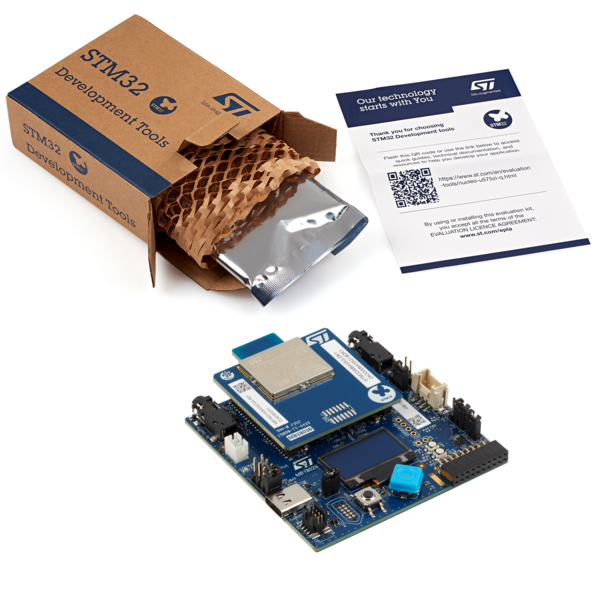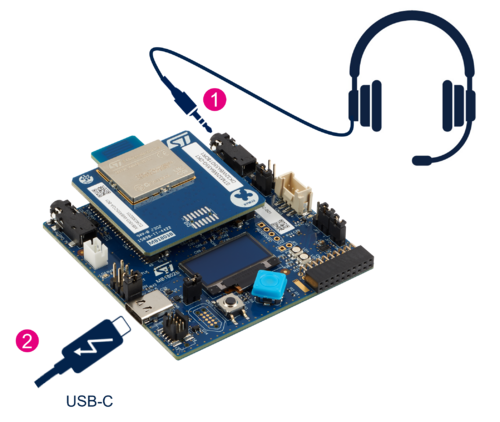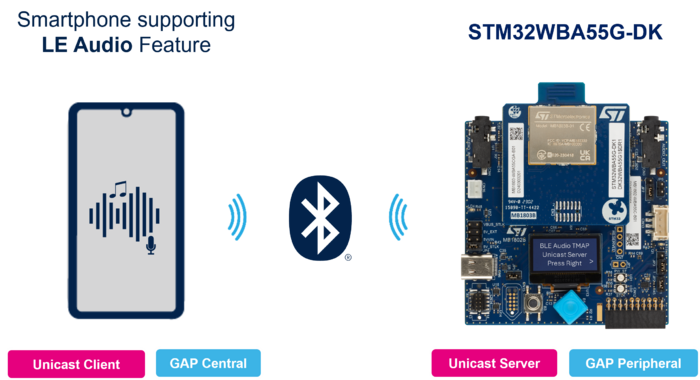1. Introduction
Welcome to the STM32WBA55G-DK[1] wiki page, which introduces our out-of-the-box demo and showcases the capabilities of our product.
This page guides you through the initial setup of our product and demonstrates how easily you can explore its features. It also provides insights on how to customize and develop your own applications.
Explore the full potential of the STM32WBA55G-DK with our comprehensive demo guide, covering everything from basic setup to advanced programming.
The demonstration application of this audio discovery kit is based on the telephony and media audio profile (TMAP).
TMAP is a highly efficient and user-friendly application that simplifies the use of Bluetooth® devices for telephony and media streaming.
For a more detailed introduction to Bluetooth® Low Energy audio, refer to the wiki article Introduction to Bluetooth LE Audio.
For a more in-depth explanation and usage of the TMAP profile, refer to the wiki article Bluetooth® Low Energy audio - Telephony & Media Audio Profile.
| Out of box STM32WBA55G-DK board package |
|---|
2. Setup
Follow the sequence below to set up the STM32WBA55G-DK and launch the demonstration application:
| STM32WBA55G-DK setup |
|---|
3. Hands on
3.1. Application interface
To begin using your STM32WBA55G-DK board, a phone compatible with LE audio features is required.
A list of compatible devices is available on the wiki article Bluetooth® Low Energy audio - Telephony & Media Audio Profile.
| OOB STM32WBA55G-DK system presentation |
|---|
In this demonstration, the smartphone allows you to establish a connection and interact with the STM32WBA55G-DK, which in a practical use case, can represent your headphones or speakers, for example.
For the rest of the demonstration, we used a Pixel 8 Pro.
3.2. Let's get started
| TMAP unicast server application's screen |
|---|
As shown above, right-click on the joystick to make your STM32WBA visible to your smartphone.
To activate the experimental Bluetooth® Low Energy audio feature on Google Pixel smartphones, first, go to the developer options menu and perform the following steps:
- Uncheck "Disable Bluetooth® LE audio".
- Check "Disable Bluetooth® LE audio hardware offload".
Now, connect to the STM32WBA_XXXX and enable the LE audio parameters.
For more detailed information, refer to the wiki article Bluetooth® Low Energy audio - Telephony & Media Audio Profile.
4. What is the next step?
Now that you are familiarized with the STM32WBA55G-DK and its out-of-the-box demo, it is time to take your experience to the next level. In this section, we will show you where to find available code, how to flash your own code onto the board, and how to develop your own applications.
Get ready to unleash the full potential of your STM32WBA55G-DK!
4.1. Test the other available applications
Other Bluetooth® Low Energy applications for the STM32WBA55G-DK are available in the STM32WBA MCU Package [2]:
The PBP addresses the use case of a broadcast in a public space, accessible by many people simultaneously: a train station, an airport, or a public TV for example.
In addition to the BLE_Audio_TMAP_Unicast_Server that we just tested, it is possible to simulate the role of a smartphone with the BLE_Audio_TMAP_Unicast_Client.
The heart rate profile, widely used in fitness applications, defines the communication process between a GATT-server of a heart rate sensor device, such as a wrist band, and a GATT-client collector device, such as a smartphone or tablet.
- BLE_HID_Mouse
Replace your mouse with the STM32WBA55G-DK using the embedded joystick and buttons.
4.2. Start your own application
The STM32CubeWBA MCU Package[2] provides software components running on STM32WBA series MCUs.
For all examples provided within the package, the following integrated development environments are supported:
- STMicroelectronics integrated development environment for STM32 products (STM32CubeIDE)
- IAR Systems® IAR Embedded Workbench® for Arm® (EWARM)
- Keil® microcontroller development kit (MDK-ARM)
The firmware package for the STM32WBA series is also available on STM32CubeWBA GitHub[3].
To learn more about the STM32WBA series MCUs or to go further based on available applications, refer to the wiki article STM32CubeWBA Bluetooth® LE MCU Package.
5. References



